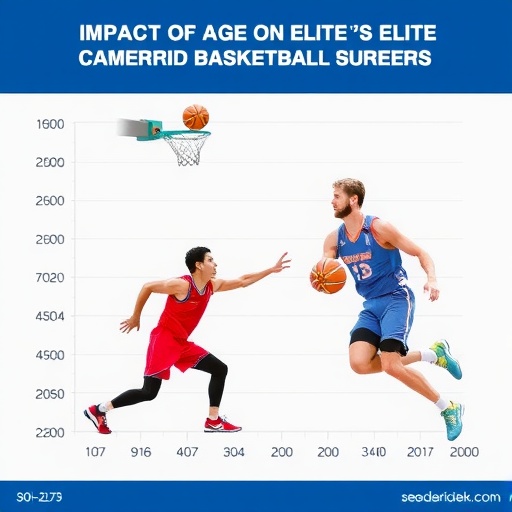Emerging research in sports science is revealing profound insights into the conditions influencing athletic performance, particularly in youth sports. A recent study led by Deng, J., Liu, Y., Wang, T., and their colleagues sheds light on a phenomenon known as the “relative age effect” (RAE) among elite junior male basketball players in China. This investigation not only emphasizes the importance of age in determining athlete success but also brings to light the broader implications this has on sports performance and talent identification.
Relative age effect refers to the advantages that younger athletes may experience in a given cohort, often resulting from the cutoff dates for age groups within youth sports programs. For instance, boys born just after the cutoff date may find themselves playing alongside peers who are significantly older and more physically developed. This study examined whether these age disparities contributed to inequalities in performance and selection processes in elite Chinese junior basketball.
Through an extensive analysis of performance metrics, the authors gathered data from various competitive environments, observing a clear trend where younger, less physically developed players struggled to compete against their older, more mature counterparts. As expected, those born earlier in the selection year consistently demonstrated higher performance statistics, suggesting that RAE could place undue burden on younger athletes, limiting their opportunities for recognition and advancement in the sport.
The methodology employed in the study was robust, utilizing statistical analyses to quantify the impact of RAE across multiple levels of competition. Researchers categorized athletes by birthdate and evaluated their achievements in regional and national tournaments. The results were telling: older athletes not only showcased superior skills but also enjoyed greater visibility, which directly correlated with their chances of being scouted and selected for further training or competition.
One intriguing aspect is how these findings may offer implications beyond mere performance metrics. The psychological impact on younger athletes often leads to decreased motivation and self-esteem, resulting in a cascading effect where they may withdraw from competitive sports altogether. By identifying and addressing RAE, coaches and sports organizations can create frameworks that promote equitable opportunities for all athletes, leveling the playing field.
Moreover, the study highlights the urgent need for a reassessment of talent identification and athlete development systems within sports federations. Traditional scouting models often favor immediate physical prowess, potentially overlooking the long-term potential of younger athletes who may subsequently catch up in skill and development. Implementing systems that consider comprehensive talent profiles, including psychological resilience and skill trajectory, is vital to nurture and retain diverse athletic talent.
While the immediate implications for youth basketball are clear, the broader application of these findings also touches on other sports where age cutoffs play a similar role. The study signifies a call to action for policymakers, coaches, and stakeholders within the sports community to reconsider age parameters and athlete evaluations, crucial for fostering inclusive and high-performing environments.
Additionally, as governments and sports associations advocate for youth involvement in athletics as a means of physical health and social development, understanding the factors influencing sport participation becomes paramount. The findings from this research could drive initiatives aimed at creating supportive training regimes that cater to a range of ages and maturity levels, helping prevent attrition rates among younger athletes who might otherwise fall behind.
As we increasingly recognize the intricacies of sport performance, this research establishes a foundational understanding of the interplay between age and athletic success—an essential consideration for the future generation of athletes. The study serves as a testament to the evolving nature of sports science, where nuanced analyses provide essential insights that could shape training methodologies and athlete development pathways.
Ultimately, discussions surrounding relative age effects underscore the need for an equitable approach to youth sports. By raising awareness about these issues, stakeholders can join forces to foster an environment that champions inclusivity, ensuring that all budding athletes have the same opportunity to shine, irrespective of the timing of their birth. The findings advocate for systemic changes that prioritize athlete well-being over competitive results, unveiling a path forward for all young players.
To engrain such changes in the fabric of youth sports, collaboration amongst coaches, parents, and sporting bodies is crucial. Emphasizing a culture focused on development, rather than solely on winning, can help mitigate the disadvantages imposed by relative age effects while promoting a love for sports among young athletes. This holistic approach promises a brighter future for sports at every level, ensuring that talent is nurtured and celebrated without bias related to age.
In conclusion, the revelation of the relative age effect in elite Chinese junior male basketball players provides a pivotal moment in understanding athletic performance. The research underscores a critical gap in consideration for age in sports talent identification and development, calling for immediate action. By challenging entrenched practices, the sporting community can pave the way for the successful and equitable participation of all young athletes, regardless of when they were born.
Subject of Research: Relative age effects in junior male basketball players
Article Title: Relative age effects and implications for sport performance in elite Chinese junior male basketball players
Article References:
Deng, J., Liu, Y., Wang, T. et al. Relative age effects and implications for sport performance in elite Chinese junior male basketball players.
BMC Pediatr 25, 910 (2025). https://doi.org/10.1186/s12887-024-05272-2
Image Credits: AI Generated
DOI: https://doi.org/10.1186/s12887-024-05272-2
Keywords: Relative age effect, youth sports, athletic performance, talent identification, Chinese basketball.
Tags: age-related advantages in sportscompetitive environments in junior basketballelite junior basketball in Chinaimpact of age on athlete performanceimplications of age in sports selectioninequalities in athlete selection processesperformance disparities in youth basketballphysical development differences in athletesrelative age effect in youth sportsresearch on junior basketball playerssports talent identification challengesyouth sports performance metrics





